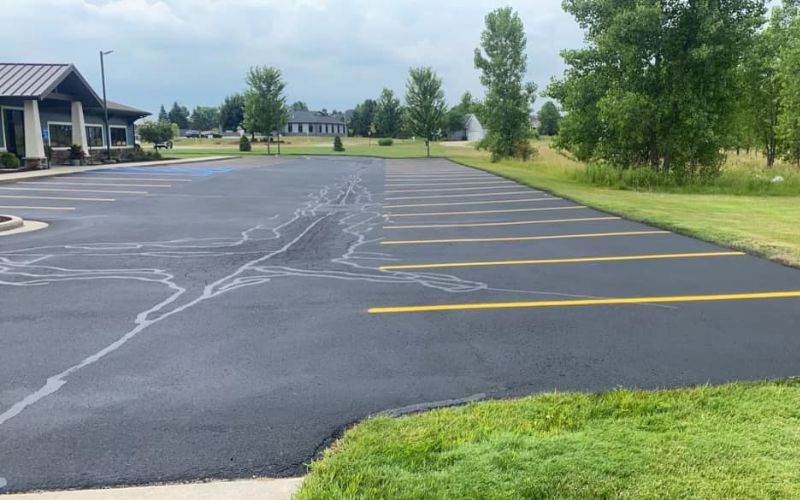Michigan’s winter leaves an indelible mark on commercial asphalt surfaces, and Jackson’s commercial properties face a unique set of challenges as the snow melts and spring emerges. The transition from winter to spring represents a critical moment for property managers, presenting both significant risks and opportunities for asphalt maintenance. Understanding and addressing the subtle damages accumulated during the harsh winter months can mean the difference between costly repairs and long-term infrastructure preservation.
The annual cycle of freeze-thaw cycles, road salt, and winter stress creates a complex landscape of potential asphalt deterioration. For Jackson businesses, from downtown commercial corridors to industrial properties on the outskirts, spring maintenance is not just a recommendation—it’s a critical business strategy that protects valuable infrastructure investments.
Assessing Winter Damage
Winter in Jackson delivers a relentless assault on asphalt surfaces, creating a complex array of potential damages that often remain hidden until professional inspection. The freeze-thaw cycle represents the most destructive natural process, with water penetrating microscopic surface openings, expanding as it freezes, and creating progressively larger structural vulnerabilities.
Visual inspection alone cannot reveal the full extent of winter-related damage. What appears to be a simple surface crack can represent a much more significant underlying structural issue. Road salt and chemical deicers compound the problem, breaking down the asphalt’s molecular structure and creating additional points of potential failure. Professional diagnostic techniques become crucial in understanding the true condition of commercial asphalt surfaces.
Experienced inspectors look for subtle signs of damage that untrained eyes might miss. Hairline cracks, slight surface depressions, areas of potential water infiltration, and signs of base layer compromise are all critical indicators of winter’s impact. These diagnostic processes go far beyond simple visual assessment, utilizing advanced technologies to create a comprehensive understanding of the pavement’s condition.
Immediate Post-Winter Inspection Strategies
Comprehensive post-winter inspection represents the foundation of effective spring maintenance. Advanced diagnostic technologies now provide unprecedented insights into asphalt condition, allowing property managers to develop targeted repair strategies before minor issues become major problems.
Ground-penetrating radar and infrared scanning have revolutionized damage assessment. These technologies can detect subsurface variations, identify potential drainage issues, and reveal hidden structural weaknesses that would otherwise go unnoticed. By creating a three-dimensional understanding of the pavement’s condition, professionals can develop precise, targeted maintenance approaches.
A thorough inspection considers multiple complex factors:
- Comprehensive surface condition analysis
- Base layer stability assessment
- Drainage pattern evaluation
- Specific winter stress impact analysis
- Potential structural compromise identification
Common Spring Asphalt Challenges in Jackson
Jackson’s unique environmental conditions create a perfect storm of asphalt maintenance challenges. The region’s dramatic temperature fluctuations during spring create ongoing stress for commercial surfaces. Freeze-thaw cycles can occur multiple times during a single week, with temperatures repeatedly crossing the freezing point and creating microscopic structural damages.
Water infiltration emerges as the most significant threat to asphalt surfaces. As winter snow melts and spring rains arrive, water seeks every possible entry point into the pavement structure. Existing cracks, no matter how minor, become potential pathways for moisture that can undermine the entire pavement foundation. Salt and chemical residues from winter treatments exacerbate this process, breaking down the asphalt’s molecular structure and creating additional vulnerability.
Pothole formation represents one of the most visible and destructive manifestations of winter damage. These cavities begin as microscopic surface openings that expand rapidly during spring conditions. The combination of moisture, temperature variations, and accumulated winter stress can transform small surface imperfections into significant structural issues in a remarkably short time.
Cleaning and Preparation Techniques
Proper spring cleaning represents a critical first step in commercial asphalt maintenance. The process goes far beyond simple surface sweeping, requiring comprehensive removal of winter accumulation and careful preparation for potential repairs. Professional cleaning techniques utilize specialized equipment designed to remove embedded debris, winter sand, and potential contaminants that can compromise surface integrity.
Advanced cleaning approaches incorporate multiple stages of surface preparation. High-powered sweeping removes loose debris, while specialized cleaning solutions address embedded contaminants. Professional teams pay particular attention to drainage areas, ensuring that winter accumulation does not create potential water infiltration points or compromise existing asphalt structures.
Repair and Restoration Strategies
Spring maintenance requires a sophisticated approach to repair that goes beyond simple surface treatments. Targeted repair techniques must address the specific types of damage accumulated during winter while preventing future deterioration. Professional teams utilize advanced materials and application techniques that provide comprehensive surface restoration.
Pothole repair represents one of the most critical maintenance activities. Modern techniques involve complete removal of damaged areas, addressing potential base layer issues, and installing specialized repair materials that provide long-term durability. Advanced cold and hot mix materials offer superior bonding and performance, ensuring that repairs become seamless extensions of the existing surface.
Preventative Maintenance Approaches
Preventative maintenance represents the most strategic approach to commercial asphalt preservation in Jackson’s challenging environment. Sealcoating emerges as a critical protective measure that goes far beyond simple surface treatment. This comprehensive approach creates a molecular-level barrier that shields asphalt from environmental stressors, preventing water infiltration, blocking UV radiation, and providing a sacrificial protective layer.
The science of preventative maintenance has evolved to become a sophisticated strategy of infrastructure protection. Modern approaches integrate advanced diagnostic technologies with precisely targeted maintenance techniques. Property managers now have access to predictive maintenance strategies that can identify potential issues before they become critical problems. This proactive approach allows for strategic interventions that can extend pavement lifecycle by decades.
Comprehensive preventative maintenance involves a holistic approach that considers multiple factors:
- Annual comprehensive inspections
- Timely crack sealing
- Strategic sealcoating applications
- Drainage system optimization
- Traffic flow analysis
- Long-term infrastructure preservation planning
Economic Considerations
The financial implications of spring maintenance extend far beyond simple repair costs. For Jackson commercial properties, a strategic approach to asphalt maintenance represents a critical investment strategy that directly impacts property value, operational efficiency, and long-term infrastructure sustainability.
Comparative cost analyses reveal dramatic economic realities:
- Reactive repair approach: $20-$50 per square foot
- Proactive maintenance strategy: $5-$10 per square foot
- Complete pavement replacement: $75-$100 per square foot
These figures demonstrate the profound financial benefits of a strategic, preventative maintenance approach. Businesses that invest in regular spring maintenance can potentially save up to 70% on long-term asphalt-related expenses. The savings extend beyond direct repair costs, encompassing reduced liability risks, improved property appearance, and minimized operational disruptions.
Insurance and liability considerations add another critical economic dimension. Well-maintained parking lots and roadways significantly reduce the risk of vehicle damage claims, potential personal injury lawsuits, and other liability issues. A professionally maintained asphalt surface communicates a commitment to safety and professionalism that can directly impact a business’s reputation and financial standing.
Seasonal Specific Considerations for Jackson
Jackson’s unique commercial landscape presents distinctive maintenance challenges that require a nuanced, localized approach. The city’s diverse commercial districts—from downtown corridors to industrial areas near the Michigan Center—each demand specialized maintenance strategies that account for specific environmental and usage conditions.
The proximity to Michigan Center and surrounding industrial zones creates unique asphalt maintenance requirements. These areas experience heavy machinery traffic, potential chemical exposures, and distinctive loading conditions that accelerate pavement deterioration. Maintenance strategies must be tailored to address these specific environmental and mechanical stressors.
University-adjacent commercial properties present their own set of challenges. Areas near Jackson College experience cyclical traffic patterns, with intense periods of use followed by relative quiet. Maintenance approaches must account for these dynamic usage patterns, potentially leveraging slower periods for more comprehensive repair work.
Technological Innovations in Spring Maintenance
The field of asphalt maintenance is experiencing a technological revolution that promises to transform infrastructure management. Advanced diagnostic technologies now provide unprecedented insights into pavement condition, allowing for predictive maintenance strategies that were previously impossible.
Infrared scanning technologies have emerged as a game-changing diagnostic tool. These advanced systems can detect subsurface variations, identify potential drainage issues, and reveal hidden structural weaknesses with remarkable precision. The ability to create comprehensive three-dimensional assessments of pavement condition represents a quantum leap in maintenance capabilities.
Eco-friendly maintenance solutions are pushing the boundaries of traditional repair approaches. Innovative manufacturers are developing asphalt mixes that incorporate recycled materials, reduce carbon footprint, and provide enhanced durability. These advancements represent a critical step towards more sustainable infrastructure maintenance practices.
Bart's Asphalt Approach to Spring Maintenance
Our approach to spring maintenance represents the culmination of decades of local expertise and technological innovation. We go far beyond standard maintenance services, offering a comprehensive infrastructure protection strategy that addresses the unique challenges of Jackson’s commercial properties.
Local knowledge forms the cornerstone of our maintenance methodology. Our team possesses an intimate understanding of Jackson’s specific environmental and structural challenges. This hyperlocal expertise allows us to develop customized maintenance solutions that provide maximum protection and long-term value.
Advanced diagnostic technologies enable us to provide unprecedented insights into pavement condition and maintenance needs. We utilize state-of-the-art assessment tools to create comprehensive maintenance strategies that address both immediate protection requirements and long-term infrastructure preservation.
Conclusion
Effective spring maintenance represents a critical strategy for protecting commercial asphalt investments in Jackson. By understanding the unique challenges presented by Michigan’s winter conditions and implementing comprehensive maintenance approaches, property managers can extend pavement lifecycle, reduce long-term repair costs, and maintain professional property appearances.
Frequently Asked Questions
Q: How soon after winter should we have our commercial asphalt inspected? A: We recommend a comprehensive professional inspection as soon as possible after the winter season, ideally within the first few weeks of spring. Early detection of potential issues can prevent more significant and costly repairs later in the year.
Q: What makes spring maintenance different from other seasonal maintenance? A: Spring maintenance is uniquely challenging due to the cumulative effects of winter damage. The focus is on addressing the specific types of deterioration caused by freeze-thaw cycles, salt exposure, and moisture infiltration that occur during the winter months.
Q: Can we wait to address minor cracks and surface issues? A: Postponing repairs is not recommended. Minor surface imperfections can quickly develop into significant structural problems, especially during the dynamic spring season. Early intervention is always more cost-effective and prevents more extensive damage.
Ready to protect your Jackson commercial property’s asphalt investment? Contact Bart’s Asphalt for a comprehensive spring maintenance assessment.



